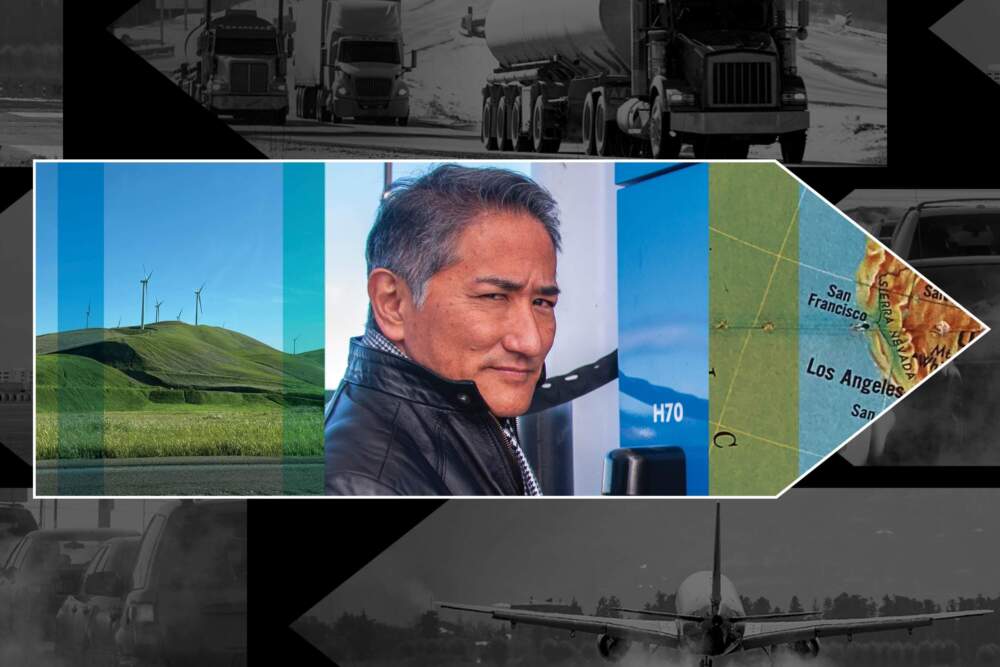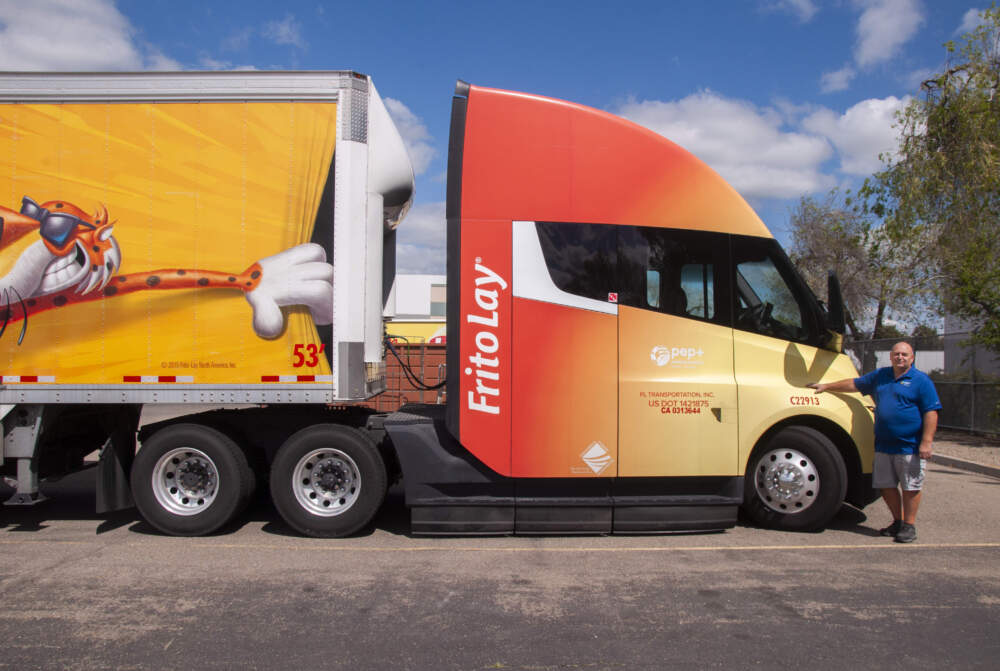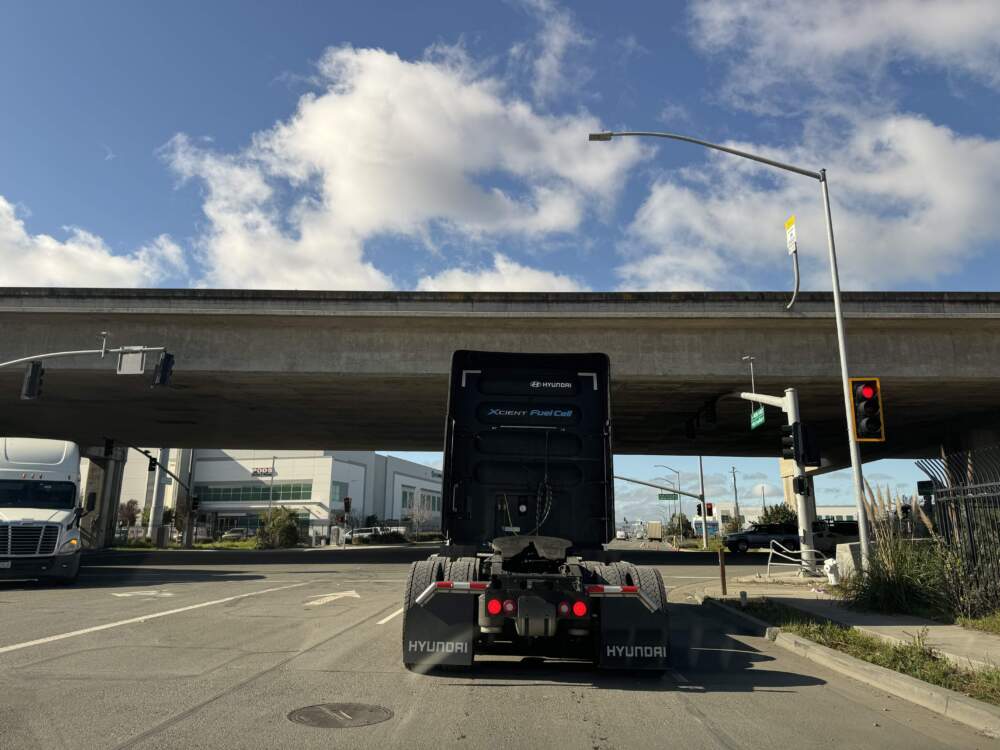Advertisement
Battery-powered big rigs could haul the future of trucking
Resume
Find out more about our Reverse Course series here.
In Modesto, California, a Dorito is born.
Millions of chips roll out of Frito-Lay’s factory every day, riding miles of conveyor belts through deep fryers, flavor dusters and bagging machines. Once they’re finished, they make the first leg of their journey to corner stores and groceries all over the world on electric trucks.
This 500,000-square-foot factory, one of Frito-Lay’s biggest, replaced its entire diesel-burning fleet with cleaner vehicles last year, from battery-powered forklifts to electric semis, built by Tesla.
Eric Tutorow hauls trailers full of Doritos and Cheetos from Modesto to distribution centers in the region. Inside the cab of his electric truck, the loudest thing besides the radio is the turn signal.
“You don’t hear the engine noise,” Tutorow says. “After driving this many years, it’s kind of nice not to go home with a headache from road noise.”

With more than 2 million miles spent behind the wheel, Tutorow says it’s a welcome change.
“I don’t know if this is particularly an answer to all our energy issues but it’s a step in the right direction,” he says. “It’s definitely an eye-opener to me."
Heavy-duty trucks travel more than 60,000 miles a year on average, so this journey is just a blip in Tutorow’s rearview mirror, but at least it’s one without a carbon footprint.
Big trucks make up only about 10% of all vehicles on the road, but they spew almost a quarter of the climate pollution from the U.S. transportation sector and almost half of lung-clogging particulate matter. Switching to electric or hydrogen-powered vehicles could make a huge impact, but getting there might be a long haul.
‘A ginormous golf cart’
Mike Roeth says stories like Tutorow’s are common: Truckers who try electric trucks are pleased with the smooth ride.
“It’s just like a ginormous golf cart,” says Roeth, executive director of the North American Council for Freight Efficiency, a trade group started about 15 years ago to help the industry save on fuel.
“People have asked me lately, ‘What happened to you, Mike? You were a diesel trucking guy and now you love battery-electric trucks.’ I remember the first time I heard about it I’m like ‘Yeah right, I mean that’s OK for cars but we’ll never haul freight with batteries."
These days Roeth is all in on battery-electric trucks. And he says more fleet managers are, too, even though the upfront cost of those Tesla semis can be twice as much as conventional diesel trucks.
“Trucking has always operated on total cost of ownership,” Roeth says. “If the truck costs twice as much but gives operational benefits in less energy costs, electricity being cheaper than diesel, less maintenance and repair, not having driver retention and attraction [issues], they’ll do it."
Still, getting over that initial sticker shock is a factor, he says. That’s why the government is subsidizing electric trucks through the Inflation Reduction Act and ramping up emissions standards for heavy-duty trucks, buses, and other large vehicles.
California has its own incentives, too, aimed at getting the state’s trucking industry to zero emissions by 2045, 10 years after its goal for passenger vehicles. Other states have signed on to the same goal, sending a signal to the people who buy heavy-duty vehicles, says Amanda DeVoe-Bice, fleet strategy and transformation director for Frito’s parent company, PepsiCo.
“Those are decisions every fleet owner is going to have to make,” DeVoe-Bice says, “but those things are turning positive for us.”
More than $15 million in state grants helped the Frito-Lay plant in Modesto electrify its fleet. The electric trucks usually make trips of about 200 miles, though they can get up to 500 miles on a charge.
One Tesla semi hauling 70,000 pounds of soda for PepsiCo made it over 1,000 miles in 24 hours, charging in three short stints. Trips like that are unusual, DeVoe-Bice says, because there are so few of the high-powered chargers that electric trucks need.
“You can get diesel and you can find a conventional, diesel fueling station nearly anywhere, which means you can drive your trucks nearly anywhere. With this zero-emissions vehicle conversion that entire framework 100 years in the making has to change,” she says. “We’re going to challenge it to change quickly, but it is going to take some time."
The company TeraWatt Infrastructure recently got $63.8 million in federal grants to build a network of high-powered charging centers for heavy-duty trucks along I-10, running from the Port of Long Beach in Los Angeles to El Paso, Texas.
Still, the lack of chargers is slowing the adoption of heavy-duty electric vehicles, prompting some truck makers to form a trade group to lobby for more federal investment in charging infrastructure.
‘Fuel of the future’
There’s another technology trying to compete with diesel that might have an advantage over batteries, at least when it comes to long-haul trips.
“Hydrogen has the unique ability to solve a number of energy and pollution issues with the convenience of liquid fuels,” says Ghassan Sleiman, chief technology officer of FirstElement Fuel. “Finally, it’s no longer the fuel of the future. It’s here now.”

FirstElement is building a hydrogen refueling depot at the Port of Oakland that Sleiman calls the first “commercial, heavy-duty” station in the world.
Part of the station is already open for business, pumping hydrogen out of a towering silo where it’s stored at negative 423 degrees Fahrenheit and into trucks equipped with fuel cells. Those fuel cells convert hydrogen into electricity with no carbon emissions.
Bill Hall drives a hydrogen fuel-cell truck made by Nikola. He says refueling is fast, just like pumping gas.
“I think that this is the future. It’s a great testament to cleaning up our environment, not emitting CO2. That’s where we need to go and there’s a lot of people like me who feel similarly,” Hall says. “And it’s really fun to drive. It’s the only truck I want to get into anymore because it’s so fun."

To meet climate targets, there will need to be a lot more electric vehicles on the road, both battery-electric and hydrogen fuel cell, says Matt Miyasato, chief public policy and programs officer at FirstElement Fuel.
“In 2036 every light duty vehicle sold and every truck sold in California has to be zero-emissions. We anticipate a large portion of those are going to be battery, but also a significant portion will be fuel cells, just because the grid can't handle that type of charging infrastructure,” Miyasato says. “We think we've cracked that nut in terms of how to solve refueling for hydrogen.”
Today, hydrogen fuel-cell vehicles make up just about 1% of traffic in California, where there are heavy subsidies to grow the industry, and even less in the rest of the country. The Biden administration is subsidizing hydrogen vehicles, and the Oakland site FirstElement is building is part of a new national network of "hydrogen hubs" intended “to accelerate the domestic market for low-cost, clean hydrogen.”
Miyasato says hydrogen is a better solution for long-haul trucks because heavy battery packs eat into how much cargo those trucks can carry.
“You can pack more fuel aboard a fuel cell truck. Marine vessels, locomotives, all those really high horsepower, heavy-duty technologies seem to be really appropriate for a fuel cell duty cycle,” he says. “You can only fund so much of a certain technology. That’s why it should be performance based and you should let the market decide.”
Truckers want clean air
However it’s done, cleaning up the transportation sector is a necessity not just for the climate, but also for people who breathe the exhaust of diesel-burning trucks. Studies have linked emissions from burning diesel to thousands of premature deaths each year in the U.S.
Next door to the Port of Oakland, a study by the Bay Area Air Quality Management District found heavy-duty diesel trucks were the leading contributor of particulate matter and higher cancer risk in the neighborhood of West Oakland.
“We’re surrounded by three freeways. We have our neighbor the Port of Oakland. We have a lot of these trucks that idle,” says Nicole Merino Tsui of the West Oakland Environmental Indicators Project, an environmental justice group. “We’re also a neighborhood that has historically and consistently been overlooked, under-resourced and disregarded.”
Tsui says “it’s time” for the port to replace as many diesel-burning vehicles as it can with hydrogen-powered and battery-electric trucks so her 6-year-old daughter and 3-year-old son can breathe cleaner air.
“I’m excited about the potential,” she says. “Truck drivers also want to breathe clean air. They also have families."

But diesel is not the only source of air pollution from trucks. Tires and brakes wear down over time, spewing harmful particles into the air.
“Even if they’re not burning diesel we get their brake wear, their tire wear,” she says. “All of these other things that really impact those of us who are in I call it ‘the stroller zone,’ it’s that two feet from the ground to six feet, it’s that zone where people are breathing in what trucks are kicking up.”
Bumps in the road
In the next 10 years, half of the country’s truck traffic could go electric, says Tim Lipman, co-director of the Transportation Sustainability Research Center at the University of California Berkeley.
“We've seen tremendous progress in battery technology. Also great progress in fuel cell technology. So the vehicles are doing really well,” Lipman says. “The challenges now are around providing the recharging infrastructure for trucks or the refueling infrastructure if it's fuel cell technology.”
There are other challenges. Too many heavy-duty trucks charging at once could strain the grid, for example. Already some developers have hit roadblocks trying to install or upgrade electrical equipment for new charging stations.
“The way I think about it is we should use batteries for everything we can initially. They are more efficient,” Lipman says. “But batteries can't do it all. If you have extra battery weight, then that's less cargo you can carry. So what the industry wants is a one-to-one replacement for their diesel trucks. They don't want to have to have three battery trucks to replace two diesel trucks because they can't carry the same weight.”
As for hydrogen, it takes a lot of energy to make the fuel and get it to refueling stations — and that’s assuming it’s green in the first place, not made from fossil fuels.
“Kind of the holy grail,” Lipman says, “is zero-carbon hydrogen coming from renewables.”
When it comes to the high cost of clean trucks, Lipman says that is likely to change. Environmental regulations are one reason it’s getting more expensive to burn fossil fuels, while electric technologies are getting cheaper.
“Diesel is inherently a dirty engine cycle, especially in terms of particulate matter. So, as the industry is required to clean up those engines more and more, that adds cost. Whereas we're going to see the cost of our electric technologies decline. So the lines are kind of crossing at this point,” he says. “I would say, though, that the climate crisis is here. We're running out of time to reduce carbon, so we need to move even faster to get these technologies out there.”
